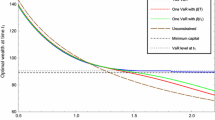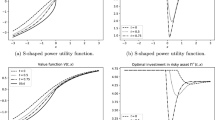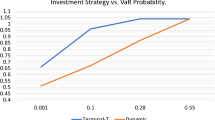Abstract
Motivated by the asset–liability management problems under shortfall risk constraints, we consider in a general discrete-time framework the problem of finding the least expensive portfolio whose shortfalls with respect to a given set of stochastic benchmarks are bounded by a specific shortfall risk measure. We first show how the price of this portfolio may be computed recursively by dynamic programming for different shortfall risk measures, in complete and incomplete markets. We then focus on the specific situation where the shortfall risk constraints are imposed at each period on the next-period shortfalls, and obtain explicit results. Finally, we apply our results to a realistic asset–liability management problem of an energy company, and show how the shortfall risk constraints affect the optimal hedging of liabilities.

Similar content being viewed by others
Notes
Very recently (while this paper was under review), the problem of hedging multiple stochastic benchmark under probabilistic loss constraints has been addressed in [4] (see Chaps. 2 and 3) using the machinery of viscosity solutions. That author works in a Markovian complete market setting, but her assumptions allow loss functions which are less regular than those in the present paper.
At this point, one may argue, see e.g. [15], that discounting fixed future liabilities at an expected rate of return of the assets runs counter to the logic of financial economics. Nevertheless, regulations that mandate such discounting practices are in place in many countries, and it is important to understand their impact in practice, and in particular to quantify the actual risk of not being able to meet the future liabilities and to identify the strategies which minimize this risk.
References
Bouchard, B., Elie, R., Touzi, N.: Stochastic target problems with controlled loss. SIAM J. Control Optim. 48, 3123–3150 (2009)
Bouchard, B., Moreau, L., Nutz, M.: Stochastic target games with controlled loss. Ann. Appl. Probab. 24, 899–934 (2014)
Bouchard, B., Vu, T.N.: A stochastic target approach for P&L matching problems. Math. Oper. Res. 37, 526–558 (2012)
Bouveret, G.: A contribution in: Hedging and portfolio optimisation under weak stochastic target constraints. PhD thesis, Imperial College, London (February 2016). Available online at http://hdl.handle.net/10044/1/33726
Boyle, P., Tian, W.: Portfolio management with constraints. Math. Finance 17, 319–343 (2007)
Cour de Comptes (French public auditor): The costs of the nuclear power sector. Public report, January 2012. Available online at: http://www.ccomptes.fr/Publications/Publications/Les-couts-de-la-filiere-electro-nucleaire
Detemple, J., Rindisbacher, M.: Dynamic asset liability management with tolerance for limited shortfalls. Insur. Math. Econ. 43, 281–294 (2008)
El Karoui, N., Jeanblanc, M., Lacoste, V.: Optimal portfolio management with American capital guarantee. J. Econ. Dyn. Control 29, 449–468 (2005)
Föllmer, H., Leukert, P.: Quantile hedging. Finance Stoch. 3, 251–273 (1999)
Föllmer, H., Leukert, P.: Efficient hedging: Cost versus shortfall risk. Finance Stoch. 4, 117–146 (2000)
Föllmer, H., Schied, A.: Stochastic Finance, 1st edn. De Gruyter, Berlin (2002)
Grossman, S., Vila, J.-L.: Portfolio insurance in complete markets: A note. J. Bus. 62, 473–476 (1989)
Gundel, A., Weber, S.: Robust utility maximization with limited downside risk in incomplete markets. In: Stochastic Processes and Their Applications, vol. 117, pp. 1663–1688 (2007)
Martellini, L., Milhau, V.: Dynamic allocation decisions in the presence of funding ratio constraints. J. Pension Econ. Finance 11, 549–580 (2012)
Novy-Marx, R., Rauh, J.: Public pension promises: How big are they and what are they worth? J. Finance 66, 1211–1249 (2011)
Van Binsbergen, J.H., Brandt, M.W.: Optimal asset allocation in asset liability management. Working paper (2006). Available at SSRN: https://ssrn.com/abstract=890891
Author information
Authors and Affiliations
Corresponding author
Additional information
This work was partially funded by Electricité de France. We thank Marie Bernhart and Bruno Bouchard for valuable comments on a preliminary version of this paper. We are also grateful to the anonymous referee, the Associate Editor and the Co-Editor for very careful reading and valuable suggestions.
Appendices
Appendix A: Technical lemmas
Lemma A.1
Let \((\varOmega,\mathcal {F}, \mathbb{P})\) be a probability space, \(X,Y \in \mathcal {F}\) and \(\alpha,\beta\geq 0\). Then
and
Proof
We begin with \(V_{0}\). By considering only one of the two constraints, we have clearly
In addition,
and so
To finish the proof, we need to find \(m^{*}\) which satisfies the constraint and realizes the equality.
Assume first that
This is equivalent to
In this case, we can take
If
we take
If finally
then we can take
Now we turn to \(V_{0}^{\prime}\). Since \(m = (X-\alpha)\vee (Y-\beta)\) satisfies the constraint, it holds that \(V'_{0} \leq\mathbb {E}[(X-\alpha)\vee (Y-\beta)]\). On the other hand,
□
We now consider the case when \(n\) is arbitrary, but the objectives are ordered.
Lemma A.2
Let \((\varOmega,\mathcal {F}, \mathbb{P})\) be a probability space, and let \(Z_{1},\dots,Z_{n} \in\mathcal {F}\) with \(Z_{1}\leq Z_{2}\leq\cdots\leq Z_{n} \) a.s. and \(\alpha_{1},\dots,\alpha_{n} \geq 0\). Then
Proof
1) Assume that there exists \(k\in\{1,\dots, n\}\) such that
Then the constraint \(\mathbb{E}[(Z_{k} - m)^{+}] \leq\alpha_{k}\) implies \(\mathbb{E}[(Z_{k+1} - m)^{+}] \leq\alpha_{k+1}\) since
We can then remove the constraint \(\mathbb{E}[(Z_{k+1} - m)^{+}] \leq\alpha_{k+1}\) without modifying the value function. Repeating the same argument for all other indices \(k\) satisfying (A.1), we can assume without loss of generality that
We then need to prove that
2) Removing all the constraints except the last one, it is easy to see that
To finish the proof, it is then enough to find \(m\) which satisfies the constraints and is such that \(\mathbb{E}[m] = \mathbb{E}[Z_{n}] - \alpha_{n}\).
3) If \(\mathbb{E}[Z_{n} - Z_{1}]\geq\alpha_{n}\), we let
and
Otherwise, let \(k^{*} = 0\) and
By construction, we have \(\mathbb{E}[m] = \mathbb{E}[Z_{n}] - \alpha_{n} \) and since \(m \leq Z_{n}\), it also holds that \(\mathbb{E}[(Z_{n} - m)^{+}] = \alpha_{n}\). To check the other constraints, observe that if \(k\leq k^{*}\), then \(m\geq Z_{k}\) a.s. and so \(\mathbb{E}[(Z_{k} - m)^{+}] = 0\). On the other hand, if \(k>k^{*}\), then \(m\leq Z_{k}\) a.s. and so by (A.2),
□
Appendix B: Explicit computations in the Black–Scholes model
In this appendix, we specialize the formulas of Propositions 4.2 and 4.3 to the Black–Scholes market with a risk-free asset evolving with zero interest rate and a risky asset which follows the Black–Scholes model
where the rate of return \(\mu\) of the risky asset is assumed to be positive.
Complete market
We assume that the agent can trade dynamically between the benchmark dates, which means that the market is complete, and the unique risk-neutral measure has density
In this case,
To compute the value function in the case of the entropic penalty, introduce the functions
where \(Z\sim N(0,1)\) and LB stands for the Louis Bachelier model. Then we obtain for \(1\leq k \leq n-1\) that \(V^{\mathit{NP}}_{k-1} = V^{\mathit{NP}}_{k}\) if \(V^{\mathit{NP}}_{k} \geq S_{k} - \rho_{k}\) and
otherwise, where \(\tilde{\lambda}_{k-1}\) is the solution to
The optimal strategy at date \(n-1\) consists of replicating the claim
This is achieved by investing a constant amount of \({\mu}/({\sigma^{2} p})\) into the risky asset between \(t_{n-1}\) and \(t_{n}\). The optimal strategy at date \(k-1< n-1\) consists of replicating the claim with payoff at date \(k\) given by
For the power loss function with \(p=2\), at the last date,
and at previous dates,
whenever \(S_{k} - V^{\mathit{NP}}_{k} > \sigma_{k}\), and \(V^{\mathit{NP}}_{k-1} = V^{\mathit{NP}}_{k}\) otherwise, where \(\tilde{\lambda}_{k-1}<0\) is the solution of
The optimal strategy at date \(n-1\) is to replicate the claim
which can be achieved with a constant proportion portfolio strategy. On the other hand, at date \(k-1< n-1\), one should replicate the claim with the option-like payoff
Incomplete market
Now we assume that the agent cannot modify her position between the benchmark dates. This means that the market is incomplete, and the return of the risky asset between date \(t_{k-1}\) and \(t_{k}\) is given by
Let \(h = t_{k} - t_{k-1}\). Then
for \(\eta>0\),
for \(\eta\in[-1,0]\), and
for \(\eta< -1\).
Rights and permissions
About this article
Cite this article
Jiao, Y., Klopfenstein, O. & Tankov, P. Hedging under multiple risk constraints. Finance Stoch 21, 361–396 (2017). https://doi.org/10.1007/s00780-017-0326-6
Received:
Accepted:
Published:
Issue Date:
DOI: https://doi.org/10.1007/s00780-017-0326-6




